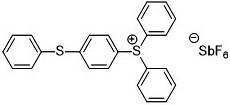製品情報
Change search condition
CPI-101A
General-purpose photoacid generator. Mono-body high-purity sulfonium salt type manufactured by our company. Excellent storage stability when mixed with cationically polymerizable resin.
Since SbF6 anion is used, it has high cationic polymerization and excellent low colorability when the cured product is heated at high temperature.
50% propylene carbonate solution.
Solvent-free type CPI-110A is also available.
 | |
| CAS RN® | 71449-78-0 |
|---|---|
| M.W. | 607 |
Physical characteristics / Packing / Development stage
| Appearance | Thin yellow liquid |
|---|---|
| Packing | 20kgCAN |
| Stage | Mass |
| Sample | Free:10g |
Q&A
- What is the absorption wavelength?
-
The i-line (365 nm) absorbs about 80 [M-1 cm-1] in terms of molar extinction coefficient. There is no absorption in the h-line (405 nm) and g-line (436 nm).
- Are there types with different generated acids?
- There are CPI-100P, which is a PF6 anion, and CPI-210S, which is a PF3(C2F5)3 anion.We also have a track record of developing sulfonates such as trifluoromethanesulfonic acid.If you have any other anions that you are interested in, please feel free to contact us.
- How much should I add?
-
Add about 0.5 to 1 wt% to the resin, depending on the application and film thickness.
- What film thickness is suitable?
-
Although it depends on the application and the amount of addition, the molar extinction coefficient is small, so even a thick film of 100 μm or more has high light transmittance in the depth direction and can generate acid to the deep part.On the other hand, in the case of a thin film of about 10 μm, the type with a large molar extinction coefficient (CPI-400 series, etc.) is suitable because the effect of transmittance is small. The CPI-300 series is suitable for medium film thicknesses of about 50 μm.
- What should I use as a sensitizer?
-
It has a high sensitizing effect for anthracenes such as dibutoxyanthracene (DBA).On the other hand, the sensitizing effect of thioxanthone such as isopropyl thioxanthone (IPTX) is low.
